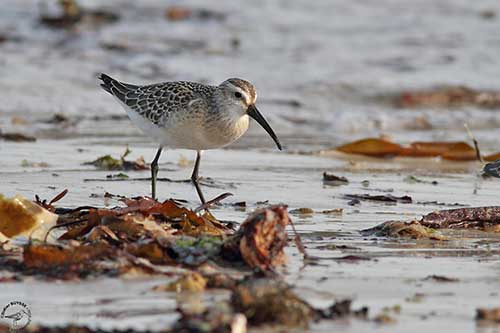
Fr: Bécasseau cocorli
Ang: Curlew Sandpipier
All: Sichelstrandläufer
Esp: Correlimos Zarapitín
Ita: Piovanello comune
Nd: Krombekstrandloper
Sd: Spovsnäppa
Photographers:
Aurélien Audevard
OUESSANT DIGISCOPING
Didier Buysse
Vision d’Oiseaux
Otto Plantema
Trips around the world
Jean Marc Rabby
Des Ailes et des Plumes
Ingo Waschkies
Bird Photography
Nicole Bouglouan
PHOTOGRAPHIC RAMBLE
Text by Nicole Bouglouan
Sources :
HANDBOOK OF THE BIRDS OF THE WORLD Vol 3 by Josep del Hoyo-Andrew Elliott-Jordi Sargatal - Lynx Edicions - ISBN : 8487334202
A Field Guide to the Birds of South-East Asia by Craig Robson. New Holland Publishers. ISBN: 9781780090498
SHOREBIRDS by Peter Hayman, John Marchant and Tony Prater – Christopher Helm – 1986 – ISBN: 0747014035
THE HANDBOOK OF BIRD IDENTIFICATION FOR EUROPE AND THE WESTERN PALEARCTIC by Mark Beaman, Steve Madge - C. Helm - ISBN: 0713639601
GUIDE DES LIMICOLES de D. Taylor - Delachaux et Niestlé - ISBN : 2603014080
Biodiversity Explorer – The Web of Life in Southern Africa
Department of Sustainability, Environment, Water, Population and Communities
What Bird-The ultimate Bird Guide (Mitchell Waite)
Wikipedia, the free encyclopaedia
Northern Territory Government - Threatened Species of the Northern Territory
NSW Government – Office of Environment & Heritage
Curlew Sandpiper
Calidris ferruginea
Charadriiformes Order – Scolopacidae Family
INTRODUCTION:
The Curlew Sandpiper is a medium-sized shorebird with long, decurved black bill and very distinctive breeding plumage. It has pointed wings and fan-shaped tail.
It breeds on the tundra of Arctic Siberia, and performs long-distance migration to spend the winter in Africa, S and SE Asia and Australasia, travelling a distance of 15,000 kilometres.
The Curlew Sandpiper is threatened by habitat loss, especially on stopover habitats. But pollution, illegal hunting and human disturbances and developments affect significantly the population of this species. It is currently classified as Near Threatened.

DESCRIPTION OF THE BIRD:
Biometrics:
Length: 18-23 cm
Wingspan: 38-40 cm
Weight: 44-117 g
The Curlew Sandpiper in breeding plumage has head, neck and underparts deep chestnut-red. The crown is streaked with dark brown. Mantle and scapulars are dark brown with white and chestnut fringes. The wing-coverts are mostly grey.
The long, decurved bill is black. The eyes are dark brown. Legs and feet are black.
Male and female are similar, but the female has usually larger bill than male. She may be slightly paler, often with white barring on the underparts.
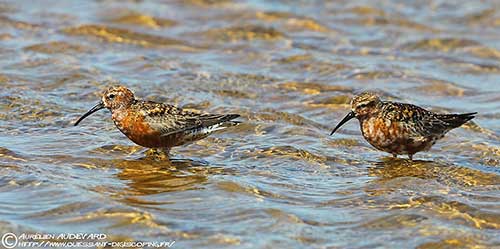
The non-breeding adult has grey upperparts with white rump and uppertail-coverts. The tail is grey. The breast sides are tinged grey but the rest of the underparts is white. We can see a broad, white supercilium, but lores and eye line are dark.
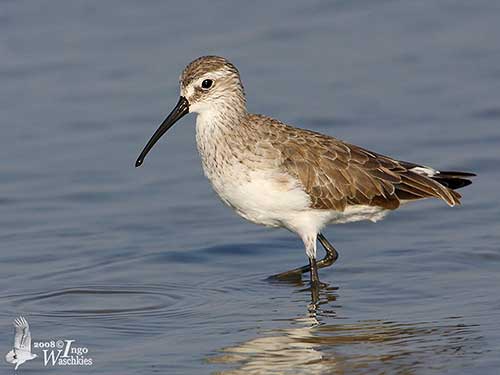
The juvenile resembles adult in winter, but it has browner upperparts with white-edged feathers, whereas the breast is tinged buff with faint streaking.
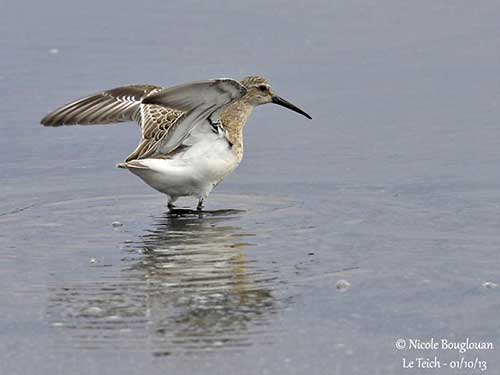
RANGE:
The Curlew Sandpiper breeds on the tundra of Arctic Siberia, from Yamal Peninsula to N Chukotskiy Peninsula.
It winters from sub-Saharan Africa through Middle-East, and S and SE Asia to Australasia.
HABITAT:
The Curlew Sandpiper breeds in wet, grassy tundra, along the coasts but also on islands in the Arctic Ocean. It often nests along low ridges and slight slopes in the tundra.
During winter, it is mainly on the coasts where it can be seen on muddy or sandy tidal flats, beaches and salt-marshes. Inland, it frequents the muddy edges of ponds and lakes, large rivers, marshes and flooded areas.
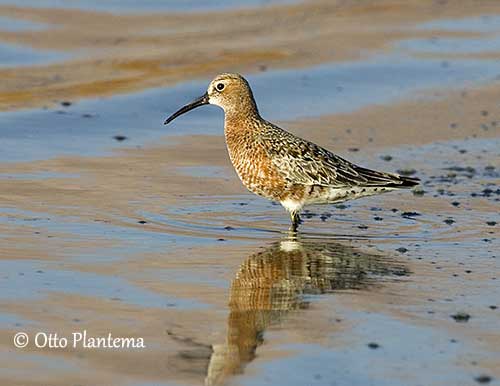
CALLS AND SONGS: SOUNDS BY XENO-CANTO
The Curlew Sandpiper gives a soft, rippling “kirrip” or “prrriit”. The song is more complex, including series of chatters, trills and whinnies.
BEHAVIOUR IN THE WILD:
The Curlew Sandpiper feeds on crustaceans (amphipods and shrimps), molluscs, marine worms and insects (mainly flies and beetles). Insects are the main part of the diet during the breeding season. Some seeds can be eaten too.
It feeds in shallow water and wet mud, pecking prey from the surface or probing in mud with the bill. It feeds both by day and by night.
Outside the breeding season, it is gregarious and forms large, mixed-species flocks on feeding areas and at roosting sites.
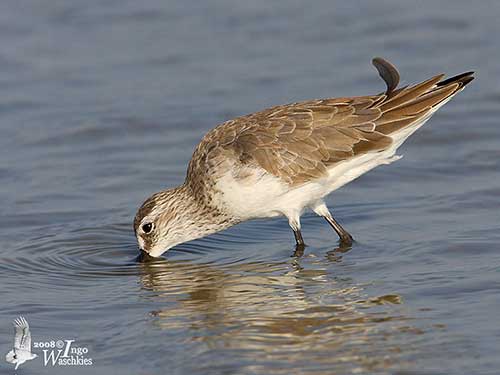
At the beginning of the breeding season, the Curlew Sandpiper establishes the territory by calling, often perched on mound or some elevated place. The male performs a low flight display with slow wingbeats interspersed with glides and accompanied by song.
Other displays show the male pursuing the female in flight. On the ground, the male circles the female, running in zigzag pattern with raised wings and fanned tail, in order to expose the white rump. Both mates also perform ritualized nest-making movements. The male does not take part in nesting duties.
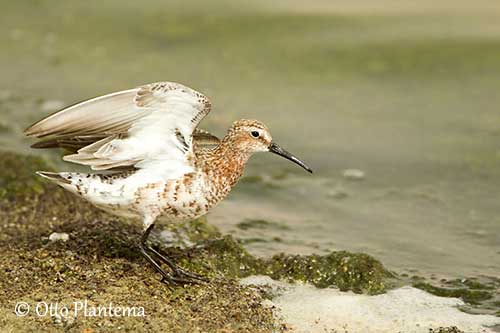
The Curlew Sandpiper is migratory. The males leave the breeding grounds in late June/early July, about 3-4 weeks before the females. They reach Africa from mid-July in north, and mostly September in south. It reaches Australia in late August/early September. The juveniles migrate 4-6 weeks later than adults.
The return migration occurs in late April to May. The breeding grounds are reoccupied from early June. The 1st year birds often remain on the breeding areas.
The Curlew Sandpiper has swift, direct flight with rapid wingbeats.
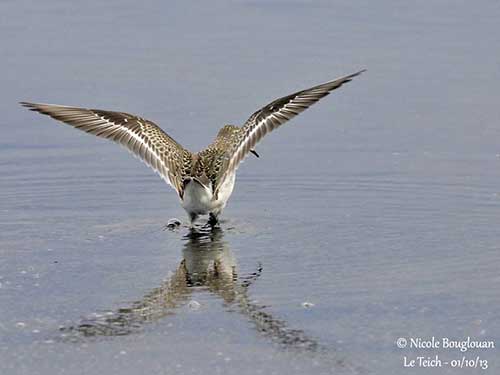
REPRODUCTION OF THIS SPECIES:
The breeding season takes place in June-July. The Curlew Sandpiper nests on the tundra close to marshes and pools, or along low ridges and gentle slopes in the wet, grassy tundra.
The nest is on the ground, with a density ranging from 2-3 nests/km², sometimes 200-300 metres apart, or up to 50 birds/km².
The nest is a shallow scrape on the ground, lined with leaves, moss and lichens. It is built by the female alone. Sometimes, several females may nest close together, involving probably better nest defence.
The female lays 3-8, usually 4 cryptic creamy-white to olive eggs with dark markings. She incubates alone during 19-21 days. The chicks leave the nest soon after hatching, and the female leads them to more grassy areas in the tundra. They are able to feed themselves, but they are accompanied by the female. They fledge two weeks after hatching.
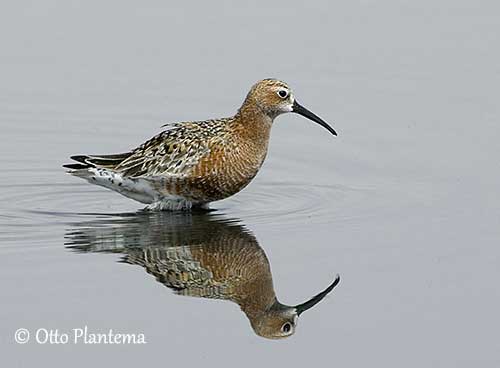
PROTECTION / THREATS / STATUS:
The breeding success of the Curlew Sandpiper depends on lemming abundance, and is much better when these small rodents are abundant because the predators hunt them and forget the sandpipers.
The Curlew Sandpiper is threatened by habitat loss through degradation of wetland with drainage, pollution and some agricultural methods. The migrating birds are losing their stopover habitats in China and South Korea, around the coast of the Yellow Sea. Human disturbance and developments, illegal hunting and diseases also affect this species.
The global population is estimated to number 1,085,000/1,285,000 individuals (2015), and this population is suspected to be declining.
The Curlew Sandpiper is currently classified as Near Threatened.
